Apple’s new iPad Pro Is Super Powerful And Has An Amazing Screen, But The iPad Air is still best for most people
The 12.9-inch iPad Pro has the same M1 processor used in some of Apple’s newest Macs. It has a really bright screen, a great front-facing camera that tracks your face in video chats as you move around and awesome performance. It’s for professional users or consumers who don’t mind spending up for really high-end features.
I’ve been testing Apple’s new 12.9-inch iPad Pro for the past week or so.
It might look similar to the last two versions, but it’s a really big upgrade that caters most to power users who use an iPad as a portable adjunct to their Mac for tasks like capturing video in the field for later editing. It has a number of features you won’t get in the iPad Air, but I still think the Air — which is several hundred dollars cheaper — is the best tablet computer for most people.
Apple’s iPads, like its iPhones and Macs, have been crushing it recently. The company reported nearly 79% year-over-year revenue growth in its last quarter, generating $7.8 billion from iPad sales alone. Some of that growth was propelled by the pandemic, but I think that trend could continue as people find ongoing use for the iPad’s portability as parts of the world begin to reopen.
For the first time, the 2021 iPad Pros are equipped with the same M1 chip that also powers the new iMac desktop and the refreshed MacBook Air, MacBook Pro and Mac Mini that were released last year. It paves the way for a future where the iPad and the Mac share more functionality, although Apple has insisted that it will keep the product lines separate for serving different uses — and as long as both are selling well, there’s no real incentive for Apple to combine them.
Here’s what you need to know about Apple’s new 12.9-inch iPad Pro.
What’s good
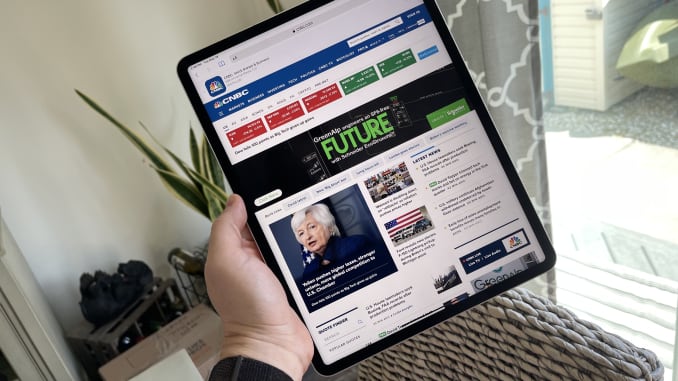
The M1 processor is fast, but you probably won’t notice that speed unless you’re doing some pretty intensive tasks like video editing. Normal tasks, like browsing the web and just opening apps, feels pretty much the same as my 2018 iPad Pro: smooth and quick.
The benefits of M1 can be seen in other places: Photo and video editing is quicker, for example. You can edit multiple streams of video at the same time in some apps, like LumaFusion.
Some new games will take advantage of added graphics power, like the recent release of the Divinity: Original Sin 2 for iPad, which lets two players play at a smoother frame rate in split-screen on an M1 iPad than on other iPad models it supports. I couldn’t see much of a difference between the game running on the new iPad Pro and my 2018 model, however.

There are other really cool benefits to the chip. Apple added a new wide-angle camera to the front of both of the new iPad Pros. It enables a feature called Center Stage, which follows you around as you’re talking on FaceTime, WebEx or any other video app that decides to use it. It’s awesome. I called my wife once, and my editor another time, and the camera zoomed out or in and followed me as I walked back and forth around the room. It’s similar to the functionality built into competing products like the Facebook Portal.
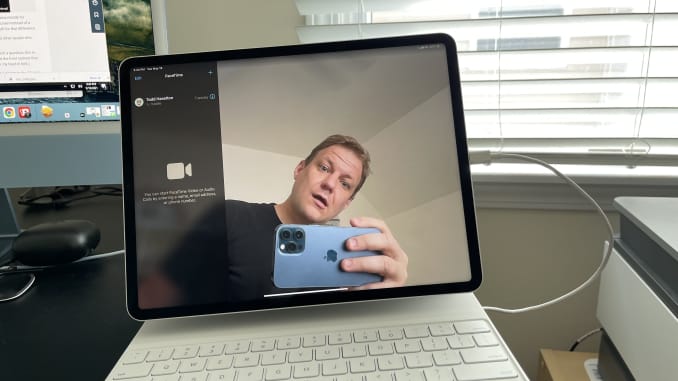
Speaking of cameras, you also get two cameras on the back, including an ultra-wide angle lens that’s fun for capturing more in a scene. There’s also the lidar camera we saw last year, which helps for augmented reality experiences. You can just start dropping digital objects on top of the real world in apps that support augmented reality, instead of waiting for the iPad to scan the room.
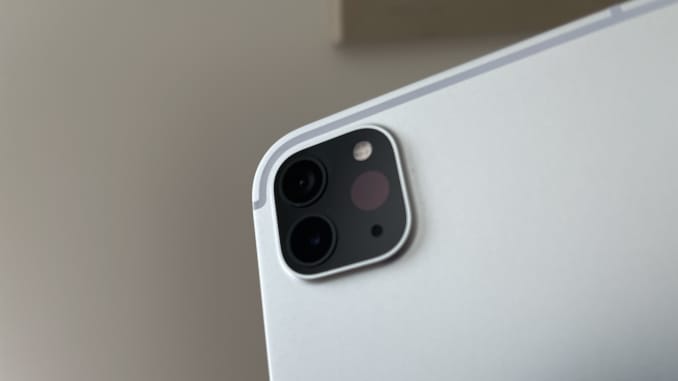
I don’t use lidar or AR very much, but it’s really useful to have if you’re doing a home project and want to use it to measure, see how new furniture might fit in a room, and so on. Apps like Procreate let industrial designers create 3D models and then drop digital models in the real world to see how they might look in person, too.
I said this last year, and I’ll say it again: The $349 Magic Keyboard makes a huge difference for people who want to work from an iPad. It adds a great trackpad, a really good keyboard that’s easy to type on, and turns the iPad into more of a laptop-hybrid. I still use a MacBook Air for most things, since I’m more productive switching between apps on macOS, but the Magic Keyboard is worth buying if you just need a tablet that serves as an occasional laptop. I just really like the versatility: I can go from working on this review outside in the backyard to lounging on the couch at night reading the news on a big screen, the latter of which isn’t as comfortable with a laptop.
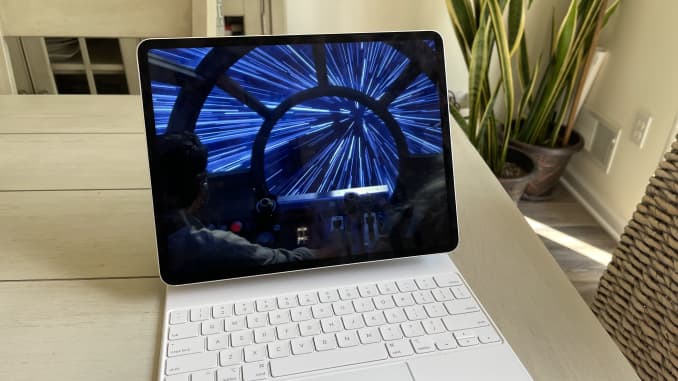
The 12.9-inch iPad Pro has a big feature the regular new 11-inch model doesn’t have: a “Liquid Retina XDR” display, which is fancy branding for using mini LEDs. This technology enables a much brighter screen for certain things, like watching HDR movies. I also found it looked brighter outside in direct sunlight than my 2018 11-inch iPad Pro.

The brightness of the 11-inch iPad Pro caps out at 600 nits. That’s the same for the 12.9-inch iPad Pro in most apps, but it has peak full screen brightness for things like HDR video of 1,000 nits, and individual mini LEDs can get as bright as 1,600 nits. That’s a little in the weeds, but it means brighter areas in a video or photo, or the difference between say a really bright sun in deep black space.
By comparison, the new iMac has 500 nits of brightness, so this is a feature professional video and photo editors will appreciate on a portable device.

The designs-for-pros trend continues to the charging port, which now supports Thunderbolt / USB 4 for faster data transfers if you’re dumping a bunch of movies or photos from a camera, for example. It supports up to 6K external displays if you want to connect it to a monitor and up to 10 Gbps Ethernet connections if you want to hardwire into your router for faster internet. Again, most folks might not use this — I don’t — but it’s there for the people who need it.
It supports the $99 Apple Pencil, which I use every now and then to jot down notes or write to search in apps (which works surprisingly well). Power users will find it useful for finely tuning or cropping parts of picture or video, especially when poking a finger at the screen isn’t precise and when you want to use it as a tablet instead of a laptop.
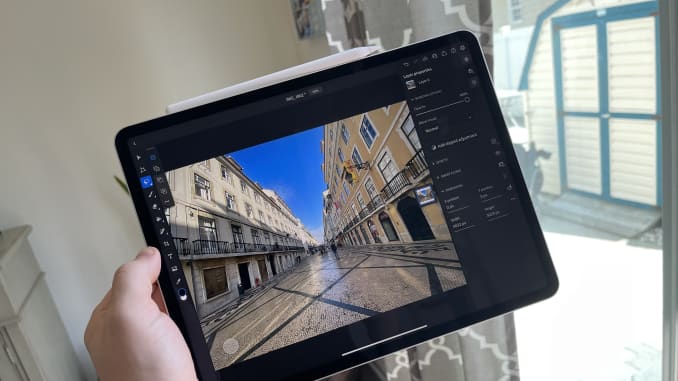
The speakers haven’t changed, but they’re still really good, offering surround sound from both sides of the iPad Pro.
The new iPad Pro supports 5G if you pay for the cellular model, about a $200 upgrade. 5G isn’t a huge deal yet, but it’s starting to become more prevalent around the U.S. and it’s great future-proofing for when you can download and upload movies, videos, files and more much faster. I didn’t have a great Verizon 5G signal at home, though, so I mostly just stuck with Wi-Fi, but I’m excited to use it for streaming Xbox games anywhere there’s a good signal, which I loved playing on the iPad over Wi-Fi.

The battery easily lasted me through a full day, but that could extend to several days on lighter usage or under a day if you’re working on a 5G cellular connection with max brightness.
What’s bad
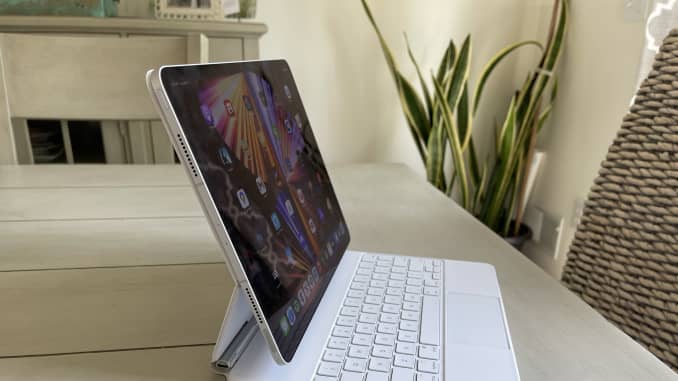
It’s not cheap.
The 12.9-inch iPad Pro, without a keyboard or cellular connectivity, starts at $1,099. A comparable MacBook Air starts at $999. Add in 5G and the Magic Keyboard keyboard and you’re going to spend $1,648 — and that’s for the minimum 128GB of storage. Boost the storage and you could easily spend more than $2,000. I totally see the portability benefits and know there are different use cases for the MacBook Air and an iPad Pro. But it’s one reason why I think the iPad Air or even the regular iPad is a better buy for people who don’t really need the awesome display or the added processing power you get with a Pro. It’s a top-of-the-line machine and it’s priced accordingly.
I think there are a few ways Apple could make this iPad even better. You can add an external display, for example, but you can’t really use it the way you’d use an external screen with a Mac — for instance, by dragging and dropping apps to it. You can just mirror the iPad screen or use some added tools and features for workflows in apps that support the additional display. This seems to be a limitation of iPadOS since we know the M1 Macs support external monitors with plenty of apps just fine.
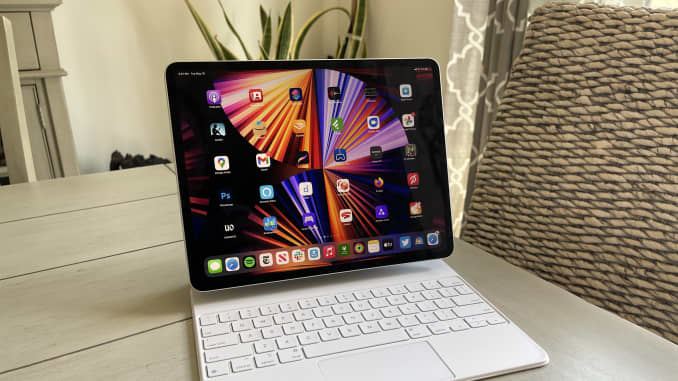
And speaking of macOS, as I said in my recent iMac review, I wish there was some sort of convergence between the two. There are times, like with an external monitor attached, that I wish I could just use macOS and have various windows open all over the place for much faster multitasking with the trackpad and keyboard.
Lastly, this is just a personal preference, but I generally like the smaller 11-inch size most of the time. It’s just easier to hold when you’re lounging in bed compared with the 12.9-inch. On the other hand, with a keyboard attached, I like the 12.9-inch better. So, my advice is to try both sizes if you’re not necessarily buying the 12.9-inch model for the brighter screen.
Should you buy it?
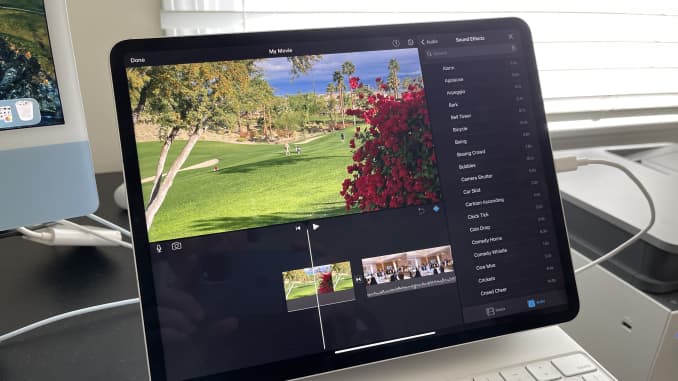
The iPad Pro continues the iPad’s decade-long evolution from a casual computing device mostly for consuming content around the house, to a full-fledged computer — only with a touchscreen instead of a built-in keyboard and touchpad like the Mac lineup, and an operating system that’s built for that difference.
The people who need the iPad Pro are professional video editors, photographers and other people who want to do heavy computing tasks in the field.
It’s also fine for people with deep wallets who just want the best iPad. If money wasn’t a question, this is the iPad I’d replace my 2018 iPad Pro with, just because I love the bright screen and the front camera that tracks me for video chats. (I’d just have to deal with holding the heavier model over my head in bed.)
But most people are going to be totally happy with the iPad Air. It gives you a similar design to the 11-inch iPad Pro. It still has a nice screen, support for things like the Apple Pencil, good cameras, and works with the Magic Keyboard if you want it.
– CNBC



